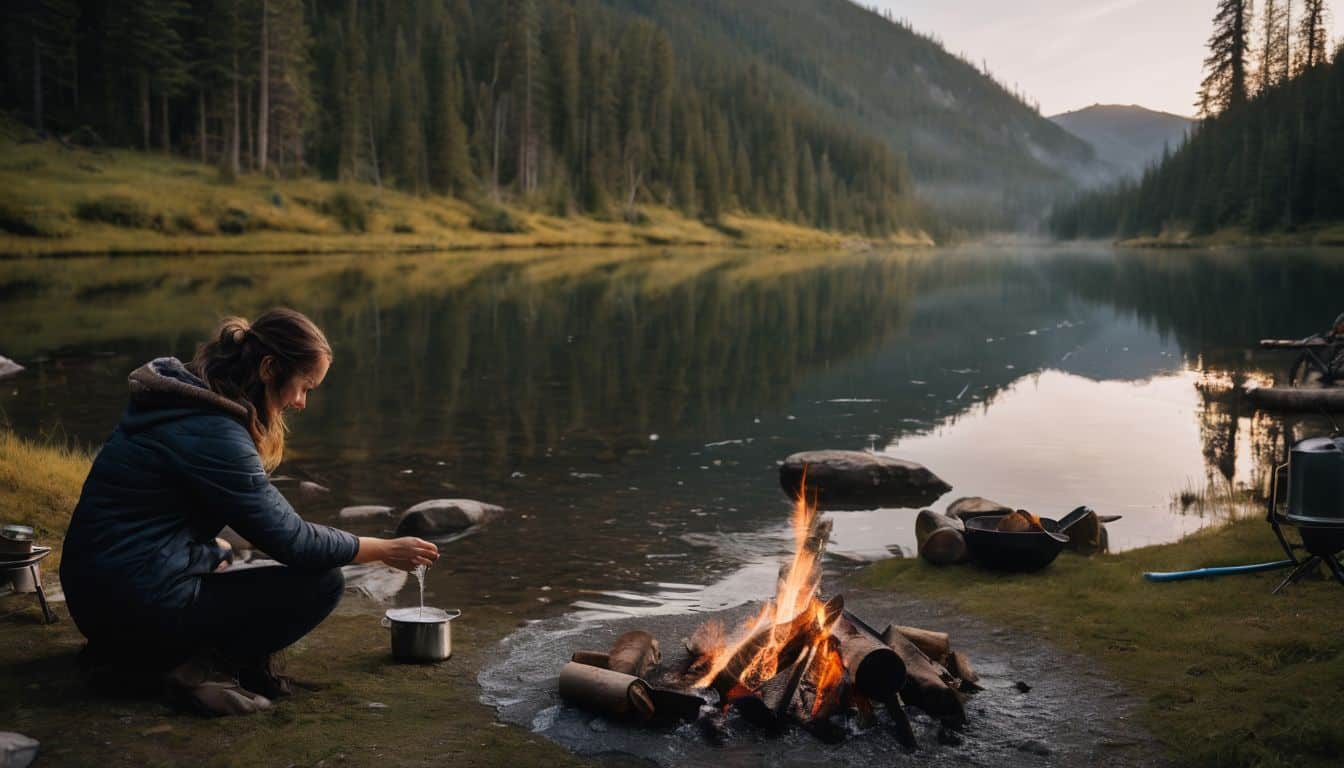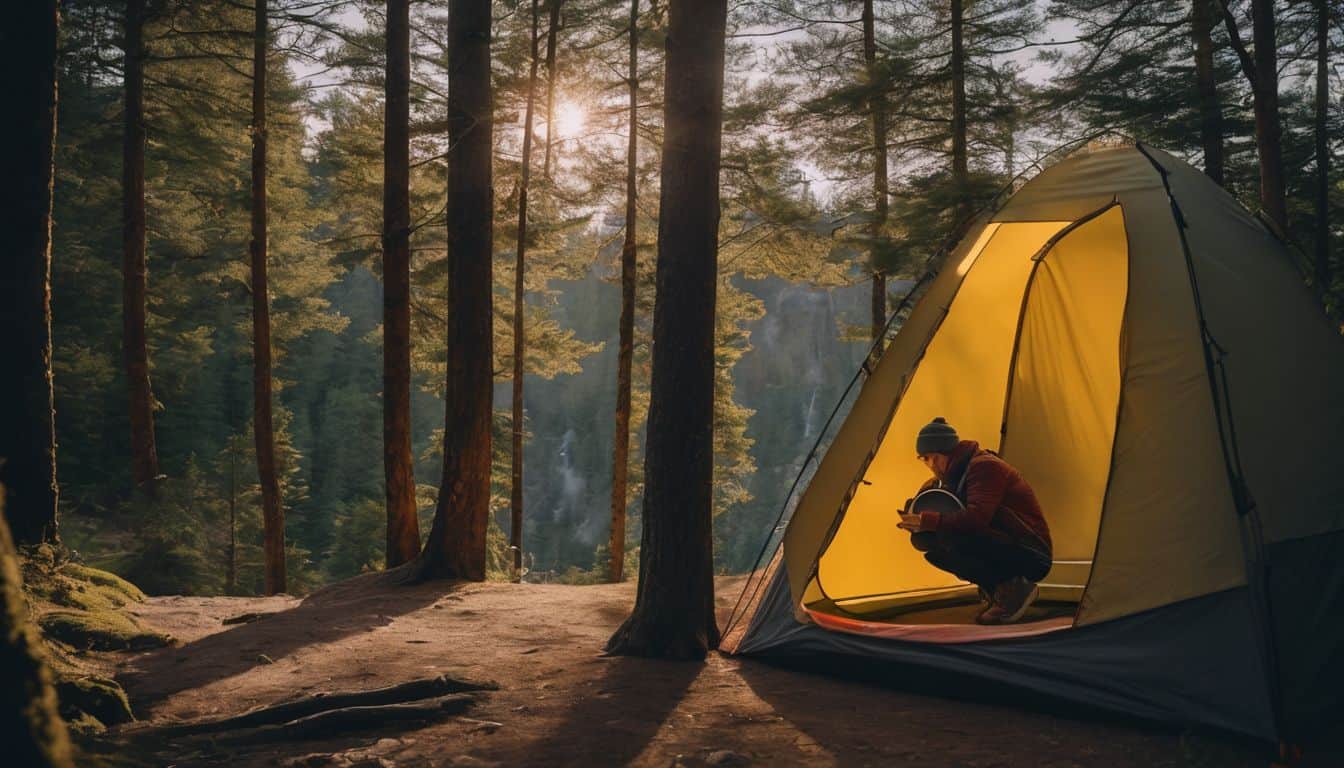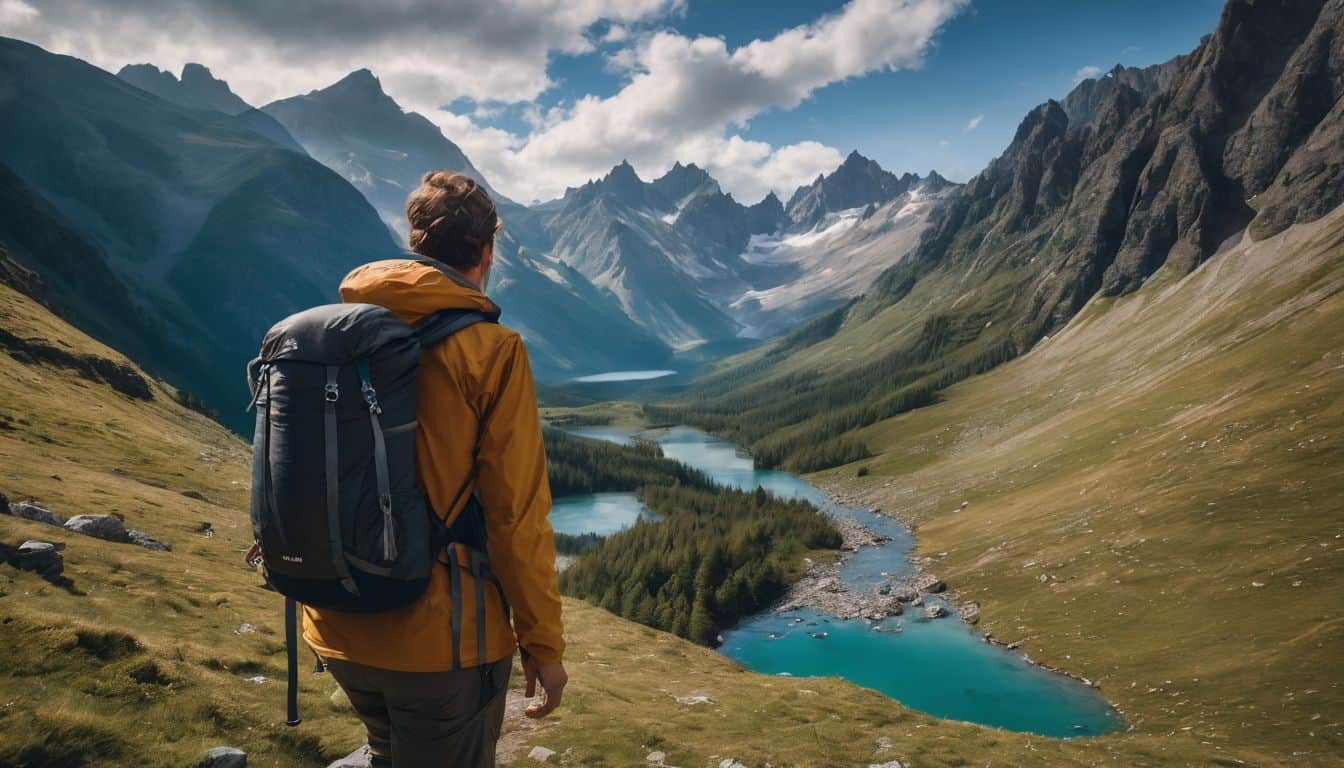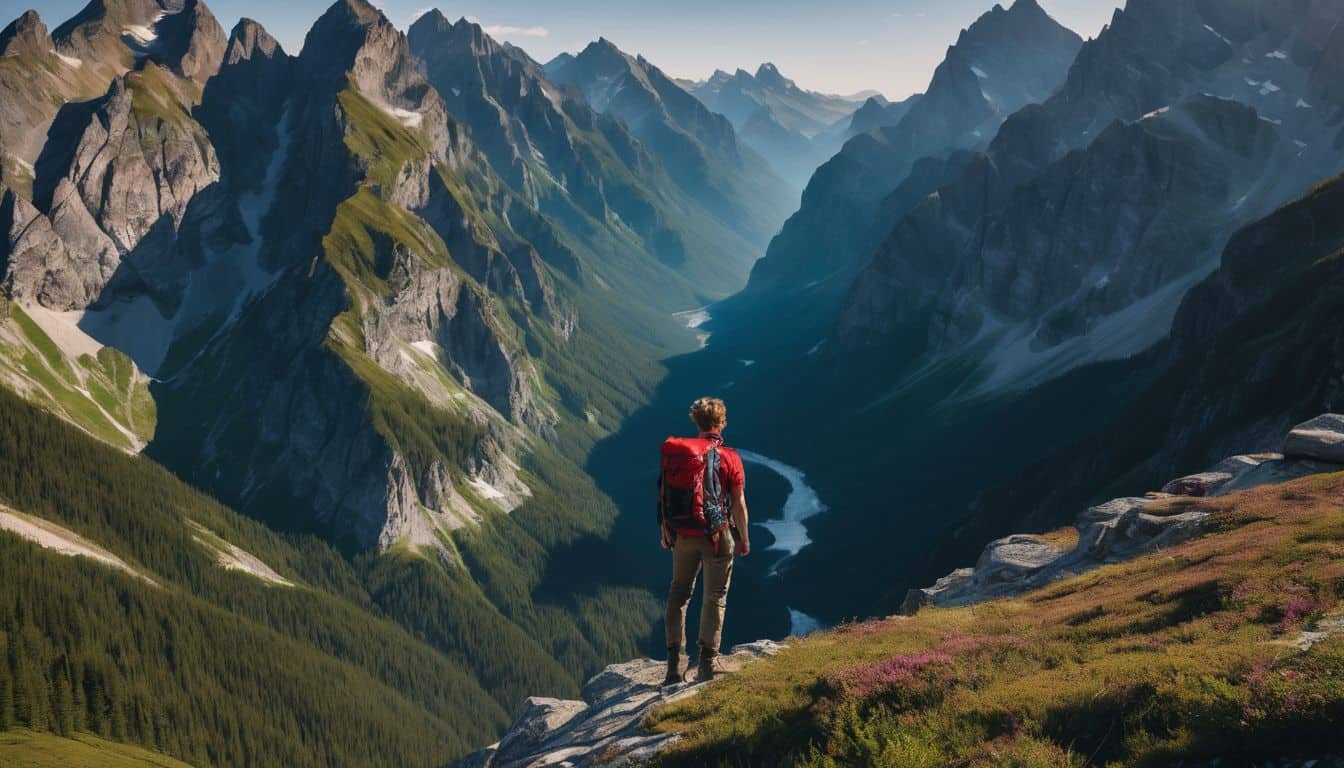Hitting the open trail? Focusing on cleanliness might not exactly be your top priority. But let’s get real, without proper wilderness hygiene and sanitation, camping can quickly shift from a thrilling adventure to an uncomfortable ordeal.
Speaking as a seasoned outdoor enthusiast who once got sidelined by illness due to neglecting simple hygiene practices while exploring the wilds, I cannot overstate its importance.
Did you know that nearly 1.6 million individuals worldwide succumb annually to diarrheal diseases because they lack access to clean water and essential sanitation? This is a sobering reminder of the crucial role of proper hygiene even in our fun-filled adventures.
Ready to make your wilderness expeditions less ‘wild’ and more hygienic? Keep scrolling for some no-fuss tips and techniques!
Key Takeaways
- Wilderness hygiene is important for staying safe and preventing the spread of illness while camping.
- Basic wilderness hygiene includes washing hands regularly, protecting food from insects and animals, cooking food thoroughly, eating cooked food promptly, and cleaning pots, pans, and utensils properly.
- Personal hygiene on a trek involves practicing bathing techniques like sponge baths or dry showers, taking care of oral hygiene and foot hygiene, changing clothes regularly, and properly disposing of waste.
- Following good wilderness hygiene practices helps protect our health and the environment during outdoor adventures.
Basics of Wilderness Hygiene and Sanitation
To stay safe in the wild, you must keep clean. This is called wilderness hygiene. It helps to stop sickness from spreading. You need to wash your hands often, especially after going to the toilet or before eating food.
Hand sanitizer can help with this when there’s no soap and water.
There are ways to keep clean even when there’s no bathroom around. You can wash clothes in a pot away from where you get your drinking water. A good bath will also make you feel fresh if you’re out on a trek for days at a time.
But it’s not just about keeping yourself tidy; it’s also about taking care of nature too. That means dealing with waste properly so that it doesn’t harm plants or animals or upset other people who may use the same space afterwards.
Nowadays, there are new types of toilets made just for these outdoor trips which make things easier.
So yes, staying clean while living off-grid isn’t always easy – but by following these basics, we can protect ourselves and the world around us at the same time.
Hygiene Tips for Camp Kitchen

Wash your hands thoroughly before handling any food to prevent the spread of bacteria and illness.
Wash your hands
I keep my hands clean. I do this to stop germs from spreading. Before I touch food, after using the toilet – always, I wash my hands. Here’s how it works.
Use warm water and soap. Then scrub your hands for at least 20 seconds. This is like humming the happy birthday song twice! Clean under your nails too because germs love hiding there.
Make sure you get every part of your hand! Handwashing helps keep me healthy in the wilds.
Protect food from insects and animals
I always make sure my food is safe from bugs and wild animals. I do this by keeping it in sealed boxes or coolers. This stops any little critters from getting inside. It’s not smart to let your food be out in the open for too long either.
Bugs can lay eggs on it and animals may smell it, you don’t want that! I also see to it that all left-overs are thrown away right away. Not doing so might lead a bear right into my camp! Cooking the food well kills harmful stuff like germs, so each meal needs to be cooked just right.
Using these tips keeps both me and the wildlife healthy while out on an adventure.
Cook food thoroughly
Cooking food thoroughly is crucial for maintaining hygiene and preventing the spread of harmful bacteria in camp kitchens and wilderness environments. When meat or raw juices come into contact with safely cooked food, it can lead to bacterial contamination and cause foodborne illnesses.
To ensure safety, it’s important to cook food at proper temperatures, following recommended cooking techniques. Additionally, always wash your hands before handling food and after handling raw meat to avoid cross-contamination.
By taking these precautions and cooking your meals thoroughly, you can greatly reduce the risk of bacterial contamination and keep yourself safe while enjoying your wilderness adventure.
Eat cooked food promptly
After cooking food in the wilderness, it is important to eat it promptly. This is because leaving cooked food sitting out for too long can lead to bacterial growth and food poisoning.
To prevent this, make sure you have a plan in place to eat your meals as soon as they are ready. If there are any leftovers, handle them with care and refrigerate them promptly to keep them safe to consume later.
By eating cooked food promptly, you will ensure that you stay healthy and avoid the risk of getting sick from contaminated food.
Clean pots, pans, and utensils
I always make sure to clean my pots, pans, and utensils thoroughly when I’m out in the wilderness. It’s essential for maintaining proper hygiene in the camp kitchen. One effective way to sanitize them is by boiling them in water.
Boiling water can disinfect these items and ensure that they are safe to use for cooking and eating. So after each meal, I take some time to boil water and let my pots, pans, and utensils soak in it for a while.
This simple step helps me maintain cleanliness and prevent any potential contamination from lingering on my cooking implements.
In addition to boiling water, it’s also important to wash and rinse dishes properly when camping. I usually bring collapsible buckets with me so that I can easily fill them with water for cleaning purposes.
Keep kitchen surfaces and utensils clean
Having clean kitchen surfaces and utensils is essential for maintaining proper hygiene in a camp kitchen. It’s important to clear off countertops and wipe surfaces with hot soapy water or a multi-purpose kitchen cleaner.
This helps to remove any dirt, bacteria, or food residue that can contaminate your cooking area. Additionally, washing utensils thoroughly after each use is crucial to prevent cross-contamination and the spread of harmful bacteria.
By keeping your kitchen surfaces and utensils clean, you’re ensuring safe food handling practices and reducing the risk of foodborne illnesses during your wilderness adventure.
Don’t share utensils
Sharing utensils like water bottles, utensils, and bowls in a camp kitchen can lead to poor hygiene and sanitation. To maintain clean and healthy camping experiences, it is important to avoid sharing utensils.
This is one of the hygiene tips for a camp kitchen that helps prevent the spread of germs and ensures each individual has their own personal items. So, remember not to share utensils while camping to promote wilderness hygiene and sanitation.
Personal Hygiene on a Trek
Maintain good personal hygiene on a trek by practicing bathing techniques, such as sponge baths or dry showers, and taking care of oral hygiene and foot hygiene. Change clothes regularly and dispose of waste properly to ensure a clean and healthy experience in the wilderness.
Bathing techniques (sponge bath, dry shower)
When you’re out in the wilderness, it’s important to maintain personal hygiene. Here are some bathing techniques you can use on a trek:
- Take a sponge bath: A sponge bath is a great way to freshen up when there’s no access to water or bathing facilities. Use a damp cloth or biowipes to clean your body, paying attention to areas that tend to get sweaty and dirty.
- Use dry shampoo: If your hair gets greasy and you don’t have access to water for shampooing, try using dry shampoo. It comes in powder or spray form and helps absorb excess oil from your scalp.
- Freshen up with baby wipes: Baby wipes are handy for cleaning purposes when water sources are not available. They are gentle on the skin and can be used to wipe away dirt and sweat.
- Carry hand sanitizer: Keeping your hands clean is crucial for maintaining good hygiene. Carry hand sanitizer with at least 60% alcohol content and use it regularly, especially before eating or preparing food.
- Change into clean clothes: Changing into fresh clothes can make you feel more comfortable and prevent the buildup of odor-causing bacteria. Pack extra sets of clothing that are lightweight, quick-drying, and easily washable.
Oral hygiene
Maintaining good oral hygiene is really important when you’re on a trek. It helps to prevent oral diseases like cavities and gum disease. To take care of your teeth, make sure to bring along a toothbrush, toothpaste, mouthwash, and floss.
Brush your teeth at least twice a day and don’t forget to clean your tongue too. Regular dental checkups are also important for keeping your teeth healthy. Taking care of your oral health is essential for overall well-being while enjoying the wilderness.
Foot hygiene
Taking care of your feet is super important when you’re out on a trek. Good foot hygiene can help prevent uncomfortable and painful conditions like athlete’s foot, blisters, and fungal infections.
Make sure to wash your feet regularly with soap and water, especially after a long day of hiking. Keep your toenails trimmed to avoid ingrown toenails and use well-fitting, protective footwear to reduce the risk of blisters.
Don’t forget to give your feet some TLC by massaging them and removing any calluses. With proper foot hygiene, you’ll be able to enjoy your trek without any foot discomfort or issues!

Changing clothes frequency
It’s important to change your clothes regularly when you’re out on a trek. This helps maintain personal hygiene and cleanliness. After reaching the camping site, it is recommended to change into clean and dry clothing.
On longer treks, it’s a good idea to change clothes more often to keep yourself fresh and comfortable. Bringing multiple pairs of underwear is also essential for multiday trips. For multiweek trips, you can wash your clothes and let them dry properly before wearing them again.
Remember, changing used clothes for clean ones every day is highly recommended for maintaining good clothes hygiene during your wilderness adventures.
Proper waste disposal
Proper waste disposal is an important aspect of wilderness hygiene and sanitation. By following these practices, you can help keep the environment clean and prevent the spread of diseases:
- Pack biodegradable trash bags: Use biodegradable bags to collect all your waste, including food scraps, wrappers, and used tissues.
- Separate recyclables: If possible, separate recyclable items like plastic bottles or aluminum cans from other waste. This reduces landfill waste and promotes recycling.
- Bury human waste: When nature calls, find a spot at least 200 feet away from water sources and campsites. Dig a hole about 6-8 inches deep, use it for your business, and cover it up properly afterward.
- Pack out toilet paper: Instead of leaving used toilet paper behind, put it in a sealed bag and dispose of it properly later.
- Dispose of feminine products properly: If you’re on your period during a trek, make sure to pack sealable plastic bags to store used sanitary products. Dispose of them in designated bins when you return to civilization.
- Avoid creating new fire rings: Use existing fire rings instead of creating new ones to minimize impact on the environment. Dispose of ashes responsibly by dispersing them after they have cooled down completely.
- Leave no trace behind: Always strive to leave the natural surroundings as undisturbed as possible by carrying out everything you brought with you.
Managing periods while trekking
Maintaining personal hygiene is crucial when managing periods while trekking. It’s important to plan ahead and take care of your personal needs during this time. Carrying unscented wet wipes can help you stay fresh and clean.
Clean hands are essential for vaginal health, so make sure to wash them with soap and water or use hand sanitizer before handling any menstrual products. Additionally, it’s important to bring necessary supplies like toilet paper, hand wash, and clean water for washing hands while in camp.
By prioritizing personal care and following these tips, you can continue enjoying your trek while staying comfortable and hygienic during your period.
Food Hygiene on a Trek
Ensure proper cutlery hygiene and pack nutritious food for a safe and healthy trek.
Proper cutlery hygiene
Proper cutlery hygiene is crucial when it comes to ensuring sanitary meal preparation during your wilderness trek. It’s important to keep your utensils clean and free from any dirt or contaminants.
One way to maintain cleanliness is by washing your cutlery thoroughly using water from a nearby source before eating. This helps rinse off any dirt particles or soil that might be present on the utensils.
By practicing good cutlery hygiene, you can help prevent foodborne illnesses and ensure the safety of your meals during your outdoor adventure.
Packing nutritious food
When it comes to packing nutritious food for a trek, here are some important tips to keep in mind:
- Choose lightweight and non – perishable foods that are rich in vitamins and nutrients.
- Opt for dried fruits, nuts, and seeds as they provide energy and essential nutrients.
- Pack trail mix or granola bars for quick and easy snacks on the go.
- Don’t forget to include whole grains like quinoa or couscous, which are high in fiber and provide sustained energy.
- Include protein sources such as canned tuna or chicken, jerky, or nut butter packets.
- Pack dehydrated vegetables or freeze – dried meals to add variety and essential vitamins to your meals.
- Remember to bring plenty of water or water purification tablets to stay hydrated throughout your trek.
- Consider bringing powdered drink mixes with electrolytes to replenish lost minerals during physical activity.
- Finally, be mindful of any dietary restrictions or allergies you may have when choosing your food options.
Essential Items to Pack for a Trek
When going on a trek, make sure to pack essential items such as proper clothing, nutritious food, and a personal hygiene kit.
Clothing essentials
When going on a trek, it’s important to pack the right clothing essentials. First, protect yourself from the sun by wearing long pants, a sun hat, sunglasses, and sunscreen lotion.
This will minimize your exposure to harmful UV rays. Second, make sure you have a warm fleece jacket or insulating layer for when it gets chilly during the trek. A waterproof jacket is also essential to protect you from rain and wind.
Lastly, don’t forget to pack extra layers of clothing for hygiene purposes. Being prepared with the right clothing will ensure you stay comfortable and protected during your wilderness adventure.
Essential eatables
When going on a trek or camping trip, it’s important to pack the right foods to keep you energized and nourished. Calorie-dense foods are recommended to fuel your hike, such as energy bars, trail mix, and dried fruits.
It’s also a good idea to carry extra food in case your trek takes longer than expected. Additionally, packing lightweight and portable meals and snacks will help sustain your energy levels throughout the journey.
Remember to choose foods that are easy to prepare and won’t spoil quickly. By being mindful of what you pack as essential eatables, you’ll be well-prepared for your wilderness adventure.
Personal hygiene kit
In my personal hygiene kit for a trek, I make sure to pack some essential items that can help keep me clean and healthy. Here’s what I include:
- Unscented, alcohol-based gel hand sanitizer: This helps me keep my hands clean when water is not available.
- Biodegradable soap: I use this to wash myself and my utensils.
- Toothbrush and toothpaste: Taking care of my oral hygiene is important even in the wilderness.
- Dental floss: This helps me remove food particles stuck between my teeth.
- Personal identification: I always carry my ID cards or any other relevant identification documents with me.
- Raincoat and backpack rain cover: These protect me and my belongings from getting wet during rainy weather.
- Reusable water container: Staying hydrated is crucial, so I bring a water bottle that I can refill along the way.
- Comfortable footwear: Having good shoes ensures that I can walk comfortably without any foot problems.
- Portable flashlight: This comes in handy during nighttime or in case of emergencies.
Differences in Hygiene for Winter and Summer Treks
Venturing into the great outdoors varies significantly between winter and summer, and so do the hygiene practices. Let me share with you how the seasons can affect your hygiene routine during treks:
– Winter treks require less frequent bathing due to low sweating.
– Summer treks, on the other hand, demand regular cleaning and bathing because of high sweat levels.
– Foot hygiene becomes crucial in winter to prevent frostbite. Always keep your feet dry and warm.
– In summer hikes, foot hygiene is equally essential to prevent fungal infections due to excessive sweating.
– Clothes need to be changed more frequently during summer treks due to sweat, while in winter, the frequency can be reduced as long as the clothes remain dry.
– Special attention is required for underwear changes during winter treks to avoid hypothermia.
– As a female trekker, managing periods during winter can be challenging because of colder conditions. Hence you need to be prepared with warm water and proper menstrual products.
– During summer hikes, you have to be extra cautious about vaginal infections due to sweating and heat.
– Food hygiene is also season-dependent. In summer, food needs to be properly stored to prevent spoilage from heat, while in winter, freezing temperatures can help in preserving food longer.
– The risk of dehydration is higher during summer hikes, making it critical to have proper water purification methods.
– In winter, you need to melt snow properly for drinking water to avoid any potential contaminants.
These differences highlight the need for season-specific hygiene practices during treks. It is all about adaptability and preparedness.
The Role of Portable Toilets in Wilderness Hygiene and Sanitation
Portable toilets play a crucial role in maintaining wilderness hygiene and sanitation by conserving water, properly disposing of waste, reducing the spread of disease, protecting vegetation and wildlife, and controlling odors.
How Portable Toilets Contribute to a Cleaner Environment
Portable toilets play a crucial role in maintaining hygiene and sanitation in the wilderness, while also contributing to a cleaner environment. These eco-friendly and sustainable sanitary solutions help conserve water by using efficient toilet systems that require less flushing.
Additionally, portable toilets provide a safe and sanitary means of waste disposal, reducing the risk of contamination and pollution. By properly managing waste through these toilets, we can protect vegetation, wildlife, and natural ecosystems.
Moreover, portable restrooms save significant amounts of fresh water annually compared to traditional toilets, making them an essential tool for promoting resource conservation and environmental stewardship.
Conserving water
Water conservation is crucial in the wilderness to ensure that we have enough freshwater for all our needs. By using portable toilets, we can save a staggering 45 billion gallons of fresh water every year.
This is significant because water scarcity and shortages are becoming more common. To conserve water, it’s important to check toilets for leaks and fix them promptly. Conventional disposal systems pose a threat to our water sources as they can pollute both ground and surface water.
Health departments advise against using more than two gallons of water for flushing toilets, so using portable restrooms is an effective way to reduce our water usage while practicing good hygiene in the wilderness.
Proper waste disposal
Proper waste disposal is crucial for maintaining hygiene and protecting the environment. When waste is not disposed of correctly, it can pose significant health hazards and lead to water pollution.
Human feces, in particular, carry harmful microorganisms that can contaminate nearby water sources if not properly disposed of. That’s why having access to portable toilets is essential when you’re out in the wilderness.
These portable sanitation facilities offer a safe and effective way to dispose of human waste, reducing the risk of contamination. So remember, always prioritize proper waste disposal to ensure both your health and the environment are protected.
Reducing spread of disease
Portable toilets play a vital role in reducing the spread of disease in wilderness environments. By providing a designated and hygienic place for waste disposal, portable toilets help to prevent the transmission of harmful bacteria and viruses between humans and wildlife.
Poor management of portable toilets can have negative consequences for public health and environmental cleanliness, so it is important to ensure that they are properly maintained. With proper sanitation practices, including the use of portable toilets, we can protect ourselves, preserve wildlife habitats, and contribute to a cleaner environment overall.
Protecting vegetation and wildlife
Portable toilets play a vital role in protecting vegetation and wildlife in wilderness areas. When people use improper sanitation methods, such as relieving themselves in nature without proper waste disposal, it can harm the environment.
Additionally, human waste contains harmful bacteria and pathogens that can contaminate soil and water sources, posing a threat to plants and animals. By using portable toilets, we ensure that waste is contained and disposed of appropriately, preventing the poisoning of trees, bushes, grass, and other vegetation with toxic substances.
This helps to maintain biodiversity and preserve wildlife habitats for future generations to enjoy. Proper hygiene practices are essential for ecological protection and sustainable sanitation in wilderness areas.
Controlling odors
Controlling odors is a crucial part of wilderness hygiene and sanitation, especially when it comes to portable toilets. Modern portable toilets have made great improvements in tackling the issue of foul odors associated with outdoor restrooms.
They use deodorizers that help control and mask the bad smells linked to human waste. These deodorizers not only reduce unpleasant odors but also provide a pleasant fragrance, making the overall experience more comfortable.
It’s important to maintain cleanliness and odor control in portable toilets to ensure they stay in good shape during events or camping trips.
History and Improvements in Portable Toilet Technology
The history of portable toilets dates back to the 1940s during World War II. They were initially created for shipyard employees who needed a mobile sanitation solution. Over time, improvements have been made to make these outdoor facilities more effective and convenient.
One significant improvement was the invention of deodorizers or blue liquid, which helps control odors and maintain cleanliness. Portable toilets, also known as Porta-Potties, are designed to be transportable and serve as temporary restroom facilities.
Today, they are widely used in various settings such as construction sites and music festivals to provide a clean and hygienic option for people’s sanitary needs.
10 Ways Portable Toilets Improve the Environment
Portable toilets play a crucial role in improving the environment in many ways. Here are 10 ways they contribute to a cleaner and healthier wilderness:
- Water conservation: Portable toilets save around 45 billion gallons of fresh water every year.
- Sustainable materials: They are made from eco-friendly and recyclable materials, reducing environmental impact.
- Vegetation protection: Portable toilets prevent toxic waste from harming vegetation in the wilderness.
- Wildlife health: By minimizing the spread of disease, portable toilets help protect wildlife populations.
- Odor control: They effectively control and minimize unpleasant odors in the surrounding environment.
- Sanitation impact: Portable toilets reduce the likelihood of diseases spreading within the community and environment.
- Environmental preservation: Using portable toilets helps preserve natural environments for future generations.
- Disease prevention: Proper waste management in portable toilets reduces the risk of diseases spreading through contaminated waste.
- Waste management: These toilets ensure proper disposal of waste, preventing pollution and contamination of water sources.
- Community hygiene: Portable toilets improve overall hygiene standards, especially in areas with limited access to sanitation facilities.
Conclusion on Wilderness Hygiene and Sanitation
In conclusion, practicing good hygiene and sanitation in the wilderness is essential for our health and the environment. By following these 9 tips, such as washing hands, properly disposing of waste, and using portable toilets, we can ensure a cleaner and safer outdoor experience.
So let’s prioritize cleanliness and make our adventures in the wilderness successful!
FAQs on Wilderness Hygiene and Sanitation
1. How can I maintain good hygiene in the wilderness?
Maintain good hygiene in the wilderness by using hand sanitizer or biodegradable soap, practicing proper waste disposal, and keeping yourself clean.
2. What should I do if there are no toilets available in the wilderness?
If there are no toilets available in the wilderness, find a spot at least 200 feet away from water sources and dig a hole to bury your waste.
3. Can I use wet wipes instead of toilet paper for outdoor sanitation?
Yes, you can use wet wipes as an alternative to toilet paper for outdoor sanitation. However, make sure to pack them out with your other trash.
4. How do I prevent contamination of water sources while camping or hiking?
To prevent contamination of water sources while camping or hiking, collect water upstream from any human activity areas and always filter or treat it before drinking.
5. What is the best way to dispose of feminine hygiene products in the wilderness?
The best way to dispose of feminine hygiene products in the wilderness is by placing them into sealable bags and packing them out with your other trash.





Leave a Reply